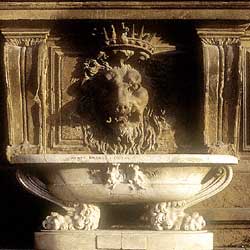|  The
original central section of this palace was constructed in 1458 by Luca
Fancelli, working from a design by Brunelleschi. It was built for an extremely
wealthy Florentine banker, Luca Pitti, who intended it to be the grandest
building in Firenze, one that would outshine that of his rivals, the
Medici. However, Luca Pitti died prematurely, and after some financial
setbacks, his heirs were forced to sell it. In 1549, it was bought by
the wife of Cosimo I, Eleonora di Toledo, who commissioned Ammannati to
enlarge it. He lengthened the facade and build a splendid courtyard inside.
Tribolo transformed the hill behind the palace into the most beautiful
Italian garden of them all: Boboli. The
original central section of this palace was constructed in 1458 by Luca
Fancelli, working from a design by Brunelleschi. It was built for an extremely
wealthy Florentine banker, Luca Pitti, who intended it to be the grandest
building in Firenze, one that would outshine that of his rivals, the
Medici. However, Luca Pitti died prematurely, and after some financial
setbacks, his heirs were forced to sell it. In 1549, it was bought by
the wife of Cosimo I, Eleonora di Toledo, who commissioned Ammannati to
enlarge it. He lengthened the facade and build a splendid courtyard inside.
Tribolo transformed the hill behind the palace into the most beautiful
Italian garden of them all: Boboli.
In 1620, the facade of the palace was once again amplified by the architect
Giulio Parigi, and the two side wings were added in the 18th and early
19th centuries. For three centuries it was the residence of the Grand
Dukes of Tuscany, and during the Napoleonic period it was occupied by
the Queen of Etruria, Napoleon's sister Elisa Baciocchi. Following the
unification of Italy, it became the residence of the Savoy royal family.
Today it is the property of the state.
In the numerous rooms of the palace there are a number of important
museums:
- the Museo degli Argenti, a collection of fine jewellery, silverware,
crystal, ivory, cameos, and textiles from the Medici collections
- the Galleria Palatina, which contains an important collection of XVII
and XVIII century painting
- the Galleria d'Arte Moderna, that dates back to 1860 and houses work
ranging from XIX century Tuscan painting to contemporary international
works
- the Museo delle Carrozze housed in one of the wings.
In the rooms of the Palazzina della Meridiana there is the Museo del
Costume, where there is a display of chronologically-ordered historical
costumes.
At the top of the Boboli Gardens, in the Edificio del Cavaliere, there
is the Museo delle Porcellane, where it is possible to admire pieces of
beautiful porcelain from the various families which have lived in the
palace.
The Royal Apartments, formerly the residence of the Grand Dukes of Tuscany,
are also partially visitable. They subsequently became the official residence
of Vittorio Emanuele II, and were also occasionally occupied by Umberto
I and Vittorio Emanuele III.
Picture by Sandro Santioli
Translated by Jeremy Carden |